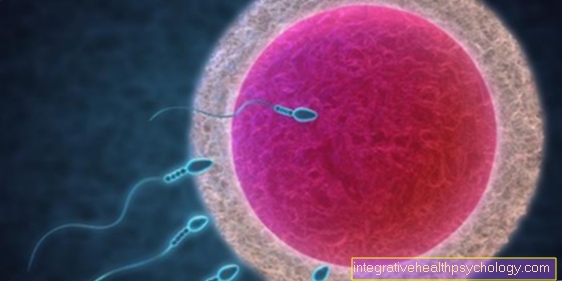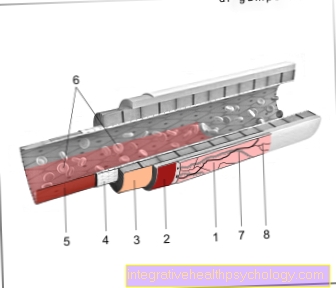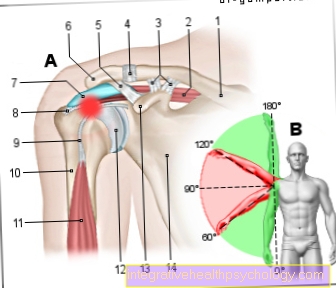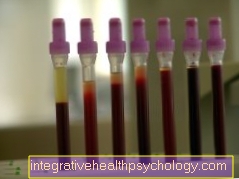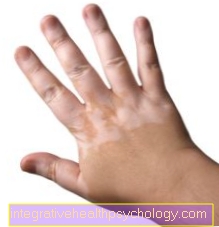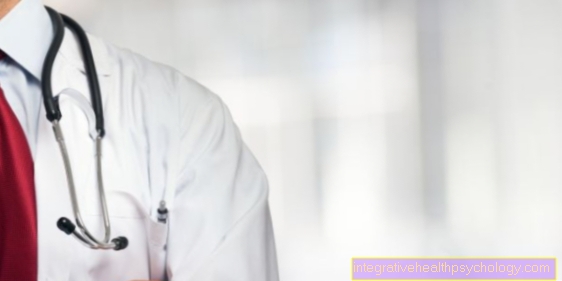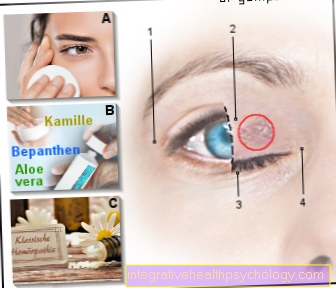Dizziness from low blood pressure
introduction
Low blood pressure, also called "arterial hypotension", describes a low pressure of the blood flow in the arterial vessels leading away from the heart.
The blood pressure, which is largely regulated by the force of contraction of the heart, ensures that all cells in the body are permanently and adequately supplied with blood and the nutrients and oxygen it contains. The central circulatory functions of the body can only be maintained through a regular heartbeat, a sufficient amount of blood in the body and an appropriate blood pressure. If the body cells need more oxygen, a reflex increase in blood pressure occurs.
If parts of this sensitive circulatory process are disturbed, there may be an insufficient supply of some cells with oxygen, which can lead to various symptoms such as dizziness.

Why can low blood pressure make you dizzy?
Overall, low blood pressure is the leading cause of sudden dizziness.
The processes behind the development of dizziness are simple, but the causes of the underlying blood pressure are often a complex interplay of numerous factors. Often there is a relative lack of blood volume, which can be caused by poor drinking behavior, bleeding, hormonal dysregulation of the body or increased water loss.
Other factors such as the female gender, pregnancy, fasting, getting up early in the morning, low physical activity, alcohol consumption, certain medication intake, getting up quickly and poor sleep hygiene all promote low blood pressure. As a result, the brain can suffer from dizziness attacks. Initially, dizziness occurs as a result of standing up suddenly and physical activity or after standing for a long time, in advanced stages even when sitting or lying down. The reason for this is the force of gravity, which also works against the blood pressure when standing and makes it difficult to supply the head with blood.
Also read:
- Dizziness during pregnancy
- Dizziness in the morning
Concomitant symptoms
Accompanying symptoms of dizziness may vary depending on the root cause.
In many cases, dizziness is followed by drowsiness, tiredness, blurred vision, nausea, vomiting, headache, fainting, and palpitations. All of this indicates a lack of oxygen in the head combined with low blood pressure. In addition to the neurological symptoms, compensatory mechanisms of the cardiovascular system mainly occur here, which want to ensure sufficient blood flow to the body cells. This can lead to palpitations and palpitations.
nausea
Nausea does not necessarily have to be attributed to upset stomach, but is a common neurological problem that is also attributed to low blood pressure.
As a result of dizziness, certain centers in the brain can be aroused, which provoke nausea and even vomiting. The organ of equilibrium is closely interconnected with the feeling of nausea. Even if the organ of equilibrium in the inner ear is not functioning properly, dizziness and nausea typically occur. However, nausea with vomiting can further worsen low blood pressure, creating a vicious circle. This leads to further loss of food and fluid, which has a negative effect on blood volume and circulatory functions. In severe cases, intravenous fluids may be necessary.
- Dizziness with nausea
fatigue
Fatigue is a typical symptom accompanying dizziness caused by low blood pressure. Fatigue is another neurological symptom that is caused by an insufficient supply of blood and oxygen to the brain.
Fatigue is also a risk factor for low blood pressure. In order to avoid circulatory problems in the long term and to counteract dizziness, you should not only drink more fluids but also sleep regularly for about 8 hours a day. However, stimulants or caffeine should not be used to counteract tiredness, as these have the opposite effect and can increase dizziness in several ways. Caffeine in particular has a diuretic effect, as a result of which the body also excretes water through the kidneys and blood pressure continues to drop.
Also read:
- Dizziness and tiredness
a headache
Headaches are a very unspecific symptom that can indicate many changes and diseases, but on the other hand can also appear without a cause.
Headaches are closely related to other non-specific neurological symptoms such as fatigue, drowsiness and dizziness. These symptoms are often mutually dependent and often occur together. In addition to low blood pressure, numerous other underlying diseases can also be responsible for the headache. A migraine, for example, can be accompanied by a so-called “aura” and lead to dizziness, drowsiness and headaches.
You might also be interested in these topics:
- Dizziness with headache
- Dizziness and migraines
High pulse
A high pulse is a typical response of the body to low blood pressure.
The high pulse itself does not cause dizziness, but it often occurs as an accompanying symptom of dizziness and other neurological symptoms. Blood pressure and pulse are closely linked in the circulatory system and together ensure adequate blood flow to the body. If the blood pressure falls due to various underlying diseases, the pulse increases automatically.
In particularly severe cases, for example severe blood loss or blood poisoning, a state of shock can occur in which the pulse even exceeds the upper blood pressure value. These can be acute and life-threatening clinical pictures. The first signs of such an imbalance are neurological symptoms such as dizziness, headache, and drowsiness.
Also read our topic:
- Dizziness and racing heart
Visual disturbances
Visual disturbance is a rarer but more serious neurological symptom that can occur as a result of low blood pressure.
Here, too, the low blood pressure in certain situations leads to an insufficient supply of certain areas of the brain with oxygen. Occasionally there may be blurred vision, double vision or even complete black vision for a few seconds to minutes. This is a threatening symptom that should be taken seriously and reported to a doctor. Various tests must be carried out for clarification in order to rule out various causes of the visual disturbances. If visual disturbances occur, low blood pressure should be treated under medical supervision.
- Dizziness and blurred vision
Numbness
The insufficient supply of body cells due to low blood pressure can be noticeable in the brain as well as in the rest of the body and the extremities.
In particular, if the legs or arms are raised, the insufficient blood pressure can lead to circulatory disorders in the toes or fingers. This first becomes noticeable as tingling and pins and needles, then also as numbness, pain or muscle weakness.
therapy
Treatment for low blood pressure depends on the underlying cause.
In the vast majority of cases, there is a relative lack of blood volume, which is favored by many factors. The most important measures for the prevention and treatment of low blood pressure are increased drinking intake, regular and sufficient meals, good sleep hygiene, moderate physical activity and avoiding coffee or diuretic medication.
If the low blood pressure is caused by other underlying diseases such as bleeding, sepsis or hormonal malfunctions, special therapies adapted to the disease must be carried out. In severe cases, the increase in blood pressure can be supported by a doctor, for example with fluid infusions and medication to support the circulatory system.
diagnosis
The diagnosis is usually made using clinical criteria and measuring blood pressure.
Symptoms, along with typical risk factors and behaviors, can already indicate low blood pressure. The exact values can then be saved with the help of a one-time or long-term blood pressure measurement. To do this, a cuff on the upper arm is inflated and the blood pressure limits are measured using certain knocking noises using a stethoscope or the fully automatic device. For domestic use, wrist blood pressure monitors are sometimes used, but they provide less accurate values.
If there is a suspicion of permanently disturbed blood pressure, a blood pressure measurement under stress and a 24-hour blood pressure measurement may have to be carried out. A provocation test can be carried out to check specific abnormal blood pressure regulation, in which the blood pressure is measured at different intervals at rest and after getting up quickly.
Course of disease
The course of the disease is strongly dependent on the severity of the circulatory restrictions and the therapy carried out.
Low blood pressure is, in most cases, a harmless, passing symptom that can include dizziness, headache, and fatigue. However, severely reduced circulation can also manifest itself in sensory disturbances, visual disturbances, drowsiness, loss of consciousness and more serious symptoms. In particularly severe cases, symptoms of shock can develop over time, which are defined as racing heart with severely reduced blood pressure. In principle, this is a life-threatening clinical picture with potential damage to all organs. The basic therapy consists of increased fluid intake in all stages of the lowered blood pressure.
Duration and forecast
The duration of the dizziness from low blood pressure is usually short. Often there are temporary and slight fluctuations in blood pressure that can be remedied by simple measures such as hydration. As blood pressure rises, all neurological symptoms subside in a very short time.
If the dizziness persists for hours or days, another underlying illness may be hidden behind the symptom. As a preventive measure, adequate fluid intake and healthy lifestyles should always be maintained to support the circulation.






